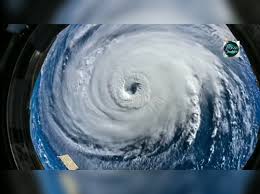Cyclone Amphan, which is intensifying regularly in the Bay of Bengal, is expected to hit West Bengal on May 20. It had formed in the southeast of the Bay of Bengal on the night of May 16, as predicted by the IMD. Monday afternoon, it is located about 770 km almost south of Paradip (Odisha), 920 km south-southwest of Digha (West Bengal) and 1 040 km south-southwest of Khepupara (Bangladesh).

The cyclone has been classified as extremely severe. IMD, which monitors the progress of the cyclone, advised fishermen not to venture into the southern Bay of Bengal in the next 24 hours; in the center of the Bay of Bengal from May 17 to 18 and north of the Bay of Bengal from May 18 to 20. The southern and northern plains of 24 Parganas and the plains of the East Medinipur district of West Bengal are susceptible to flooding due to a storm surge, a rise in sea level as a result of storms.
The IMD warns of significant damage to all types of kutcha houses, and certain damage to “pucca” structures following the cyclone. IMD also warned against widespread uprooting of communication and electricity poles, disruption of rail or road links in various locations, and damage to standing crops, plantations and orchards.
According to the meteorological office, when the cyclone hits Bengal, the wind speed varies from 165 to 175 km / h with gusts up to 185 km / h. In comparison, last year, Cyclone Fani, which was the most powerful tropical cyclone to hit Odisha since 1991, had wind speeds of up to 200 km / h.
How do cyclones form?

Tropical cyclones generally form on warm ocean waters near the equator. Hot, humid air rises above the ocean, creating an area of low atmospheric pressure below. This causes cold air to enter the surrounding areas. However, this air also heats up and rises, causing more cold air to enter. This process continues to cause a cyclonic storm. The hot air, which contains water vapor, rises and cools, forming clouds. This whole system of clouds and winds rotates and grows, constantly supplied by ocean heat and water evaporating from the surface of the ocean. As the storm system rotates faster and faster, an eye forms in the center.
The conditions are very calm and clear to the eye. When the wind speed reaches 119 km / h, the storm is officially a “tropical cyclone”. Tropical cyclones generally weaken when they land, as warm ocean waters no longer “feed” them. However, they drop several inches of rain and often cause damage from strong winds before being completely extinguished. Strong winds also bring water to the coast, which can cause flooding. The phenomenon, known as storm surges, can be dangerous for coastal areas. Cyclones are classified into five categories based on the strength of the winds produced and the damage they are expected to cause.
How did Cyclone Amphan get its name?

Six regional specialized metrology centers (RSMCs) and five regional tropical cyclone warning centers (TCWC) around the world are mandated to issue alerts and name tropical cyclones.
The Indian Department of Meteorology is also one of six RSMCs that provide advice on tropical cyclones and storm surges to 13 WMO / ESCAP Group countries, including Bangladesh, India, Iran, Maldives , Myanmar, Oman, Pakistan, Qatar, Saudi Arabia, Sri Lanka, Thailand, United Arab Emirates and Yemen. RSMC New Delhi should also name tropical cyclones that develop over the northern Indian Ocean (NIO), including the Bay of Bengal (BoB) and the Arabian Sea (AS).
Why naming of Tropical Cyclones are done?
It will help the scientific community, disaster managers, the media and the masses in general to identify each cyclone individually, raise awareness of its development and also help to eliminate confusion about the simultaneous occurrence of tropical cyclones in a region. , remember the tropical cyclone. Easily, quickly, and efficiently, warnings reach a wider audience because of names.
Tropical cyclones that form in different oceans are designated by the relevant RSMCs and TCWCs. Under the standard procedure, the RSMC in New Delhi designates tropical cyclones for the northern Indian Ocean, including the Bay of Bengal and the Arabian Sea. The twenty-seventh meeting of the WMO / ESCAP Expert Group on Tropical Cyclones (CTP) was held in 2000 in Muscat, Sultanate of Oman. During the discussion, they agreed in principle to name the tropical cyclones of the Bay of Bengal and the Arabian Sea. After lengthy deliberations, the appointment of tropical cyclones over the northern Indian Ocean started from September 2004. The list contains the names proposed by the 8 member countries of the PTC WTC / ESCAP, including Bangladesh, India, the Maldives and Myanmar. , Oman, Pakistan, Sri Lanka and Thailand. Let us tell you that almost all of the names on the list have been used to date except the last name (Amphan). Therefore, the name “Amphan” is used in the above list.
It will help the scientific community, disaster managers, media and general masses to identify each cyclone individually, it generates awareness about its development, it also helps in removing confusion regarding the simultaneous occurrence of Tropical Cyclone over a region, it.

More Stories
AIBE 19 Result: Bar Council of India to Announce Soon – Key Details for Candidates
CUET PG 2025 Admit Card: Key Details and Important Updates
Changes in CUET Subject Combinations: Impact on Science and Commerce Students